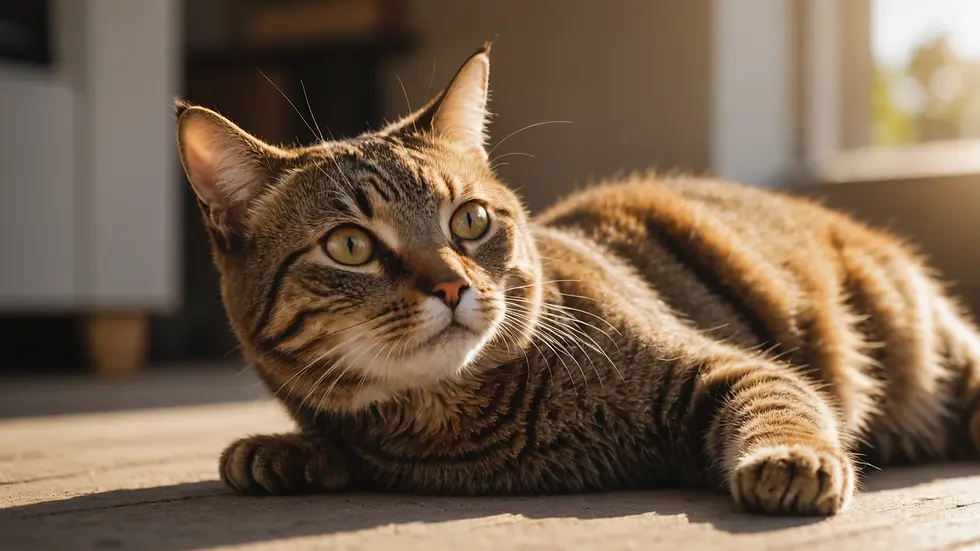How to Tell If Your Cat Is Getting Enough Exercise: A Guide for Pet Owners
- Jyotiraj Borah
- Feb 6
- 4 min read
As pet owners, we all want the best for our furry friends. Keeping our cats active is essential for their physical and mental health. But how can you tell if your cat is getting enough exercise? In this guide, we will explore clear signs that show a healthy activity level in your feline companion.
Importance of Exercise for Cats
Cats are natural hunters, and they need regular physical activity to thrive. Exercise helps them maintain a healthy weight, enhances their mood, and reduces unwanted behaviors. For instance, studies show that overweight cats are at higher risk for health issues, such as diabetes and joint problems. A well-exercised cat, on the other hand, is less likely to scratch furniture or become overly vocal.
Consider various activities to keep your cat engaged. Whether it's an interactive play session with toys like feather wands or allowing them to explore around the house, a variety of experiences helps keep your cat active and mentally stimulated.
Signs Your Cat Is Getting Enough Exercise
1. Healthy Weight
A cat's weight is one of the most telling signs of its activity level. If your cat has a good body condition score (a scale from 1 to 9, where scores around 4 or 5 indicate a healthy weight), where you can easily feel the ribs but they are not sticking out, it likely means your pet exercises regularly. According to the Association for Pet Obesity Prevention, around 60% of indoor cats are classified as overweight. Keeping your cat in the healthy range can help prevent these statistics from affecting your pet.

2. Playfulness
A healthy cat is often a playful one. If your cat shows enthusiasm for chasing toys or climbing, it indicates a good activity level. For example, cats that play regularly can be 30% less likely to become destructive, according to pet behaviorists. Look for signs such as your cat initiating playtime or actively engaging with its environment.
3. Good Behavior
Regular exercise leads to better behavior in cats. If your cat is calm, friendly, and well-adjusted, it suggests they are getting enough activity. Unexercised cats often exhibit issues like aggression or excessive meowing. According to recent studies, 70% of behavioral problems in cats can be traced back to a lack of exercise. With adequate physical activity, you may notice fewer behavioral complaints.
4. Energy Levels
Monitor your cat's energy levels throughout the day. A well-exercised cat will engage in play and exploration. If your cat has bursts of energy followed by regular rest periods, it shows a balanced lifestyle. Conversely, if your cat is excessively sleepy or lethargic with little interest in play, it may not be getting enough exercise.
5. Exploration and Curiosity
Cats are naturally curious. If your cat frequently investigates new areas of your home, it is a good sign of activity. A cat that has plenty of exercise might be seen climbing to high spots or seeking out new hiding locations. For instance, cat owners often notice that active cats search for new places to perch, demonstrating their curiosity.

6. Healthy Coat Condition
Exercise contributes to better blood circulation, promoting a healthy coat. A cat that gets enough exercise usually has a shiny and smooth coat. On the other hand, a dull or unkempt coat can be a sign of inadequate activity. Regular grooming combined with exercise helps distribute natural oils in your cat's skin.
7. Not Overweight
Keep an eye on your cat's weight trends. If you notice a steady increase, it could indicate insufficient exercise. A significant portion of indoor cats has gained weight, leading to health problems. Tracking weight and discussing exercise plans with your vet can help you implement a strategy to keep your cat fit.
Tips to Ensure Your Cat Gets Enough Exercise
1. Interactive Play
Involve your cat in play with interactive toys. Utilize feather wands, laser pointers, or balls to spark your cat's hunting instincts. Aim for at least 15 to 30 minutes of playtime each day to ensure your cat remains active and engaged.
2. Provide Climbing Structures
Cats love to climb. Offer cat trees, shelves, or scratching posts to encourage vertical exploration. This not only helps with physical exercise but also provides mental stimulation, keeping your cat engaged.
3. Encourage Exploration
Create safe opportunities for outdoor exploration. A secured catio or a harness and leash allows your cat to enjoy the outside world while remaining protected. Outdoor activities can boost curiosity and aerobic exercise, enhancing your cat’s overall health.
Keep Your Cat Active and Happy
Being proactive about your cat's exercise needs is vital. By recognizing the signs indicating sufficient activity, you can help maintain their physical and mental health.
Observe your cat's weight, energy, playfulness, and overall behavior. Implementing regular exercise into your pet's routine can lead to a happier, healthier life.

Incorporating these practices will not only enrich your cat's life but also strengthen your bond with them. Remember, an active cat is a happy cat!




Comentarios